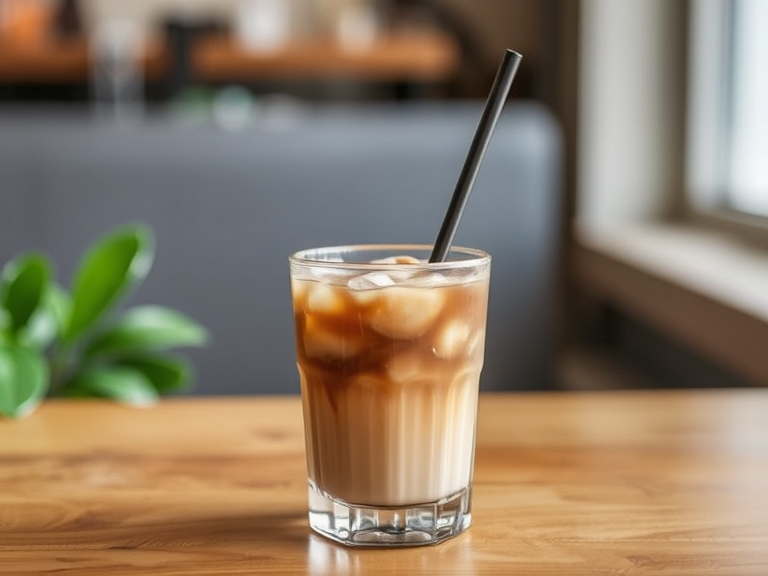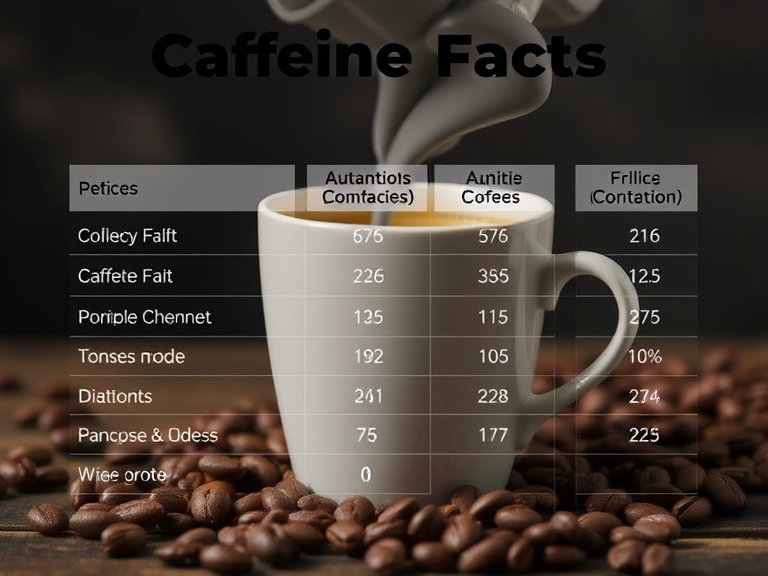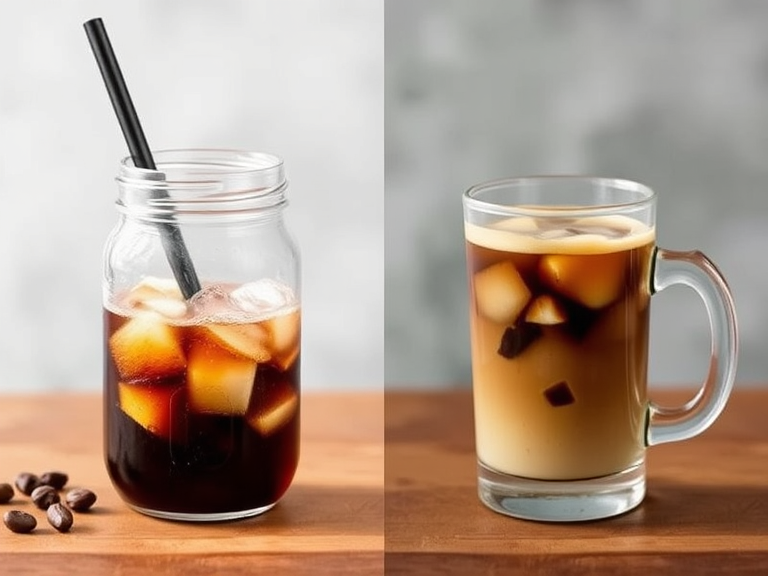Coffee lovers have many choices when it comes to enjoying their favorite cold coffee drinks. Two popular options are cold brew and iced coffee.
Also Read: The Ultimate Guide to Cold Brew vs Iced Coffee:
This guide will help you understand the key differences between these refreshing beverages.
What is Cold Brew Coffee?
Cold brew coffee is made by steeping coffee grounds in cold water for 12-24 hours. This slow process creates a smooth, less acidic coffee concentrate. The grounds never touch hot water during the entire brewing process.
The cold brew method pulls out different flavor compounds from the coffee beans. This results in a naturally sweeter taste with chocolate and nutty notes. Many people find cold brew easier on their stomachs because of its lower acidity.
What is Iced Coffee?

Iced coffee is regular hot coffee that’s been cooled down and served over ice. Baristas brew it using standard hot water methods like drip coffee makers or pour-over. They then cool it quickly by adding ice or refrigerating it.
This traditional method is faster than cold brew. It maintains the familiar coffee taste that most people know and love. The hot brewing process extracts more acids and oils from the beans.
Key Differences in Brewing Methods
Temperature and Time
Cold brew uses room temperature or cold water over many hours. This gentle extraction takes between 12-24 hours to complete. Iced coffee starts with hot water at 195-205°F (90-96°C) and takes only a few minutes to brew before cooling.
Coffee-to-Water Ratio
Cold brew typically needs more coffee grounds. The usual ratio is 1:4 or 1:5 coffee to water. Iced coffee uses standard ratios around 1:16 or 1:17. This makes cold brew more concentrated at first, requiring dilution before drinking.
Equipment Needed
For cold brew, you need:
- A large container or special cold brew maker
- Coarse coffee grounds
- Filter or strainer
- Patience for the long brewing time
For iced coffee, you need:
- Regular coffee maker or pour-over equipment
- Medium-ground coffee
- Ice cubes
- Glass for serving
Flavor Profile Comparison
Cold Brew Characteristics
Cold brew offers a smooth, full-bodied taste. It has about 65% less acidity than hot coffee. The flavor notes tend toward chocolate, nuts, and caramel. Many people describe it as naturally sweet without adding sugar.
The lower acidity means you can taste more subtle flavors. Cold brew stays fresh longer in the refrigerator, usually up to two weeks. The taste remains consistent as it sits over ice, without becoming watered down.
Iced Coffee Characteristics
Iced coffee provides a brighter, more traditional coffee flavor. It keeps the aromatic compounds that hot brewing releases. The taste can be more complex, with fruity and floral notes coming through.
However, iced coffee can become diluted as the ice melts. It’s best enjoyed right after preparation. The higher acidity gives it that familiar coffee bite that many people enjoy.
Caffeine Content and Effects

Cold brew generally contains more caffeine than iced coffee. This happens because of the longer steeping time and higher coffee-to-water ratio. A typical 16oz cold brew has about 200mg of caffeine. The same-sized iced coffee usually has 165mg.
The caffeine in cold brew is released more slowly into your bloodstream. This can provide a more sustained energy boost without the jitters. Iced coffee might give you a quicker caffeine spike followed by a faster drop.
Health Benefits and Considerations
Cold Brew Benefits
Cold brew’s lower acidity makes it easier on sensitive stomachs. It’s less likely to cause acid reflux or heartburn. The gentle extraction process preserves more antioxidants. The smooth taste means people are less likely to add sugar or cream.
Iced Coffee Benefits
Hot brewing releases more chlorogenic acids, which may boost metabolism. These compounds also have antioxidant properties. The familiar taste profile means you know exactly what to expect from your drink.
Cost Comparison
Making at Home
Cold brew requires more coffee beans per batch. However, you can make a concentrated batch that lasts two weeks. This makes it cost-effective over time. The initial investment in equipment is low, needing only basic items.
Iced coffee uses fewer beans but needs to be made fresh each time. The equipment cost varies based on your preferred brewing method. You’ll need to stock more ice and use it frequently.
Buying at Cafes
Cold brew typically costs $1-2 more than iced coffee at cafes. This reflects the longer preparation time and higher amount of coffee used. However, the concentrate can be stored longer, saving cafes money on waste.
Best Uses and Occasions
When to Choose Cold Brew
Cold brew works best when you:
- Want a smooth, less acidic drink
- Need to make coffee ahead of time
- Prefer drinking coffee in black
- Have a sensitive stomach
- Like to experiment with coffee concentrates
When to Choose Iced Coffee

Iced coffee is ideal when you:
- Want traditional coffee flavor
- Need coffee quickly
- Like adding different flavors and milk
- Prefer a brighter taste
- Want to spend less on beans
Storage and Shelf Life
Cold brew concentrate stays fresh in the refrigerator for up to two weeks. Store it in an airtight container to maintain freshness. The stable chemistry means the taste won’t change much over time.
Iced coffee should be consumed within 24 hours for the best taste. The flavors start to break down quickly, especially if milk or sweeteners are added. It’s best to make only what you’ll drink that day.
Seasonal Considerations
Cold brew works well year-round because you can serve it hot or cold. Simply dilute the concentrate with hot water for a warm drink. This versatility makes it popular in cafes.
Iced coffee sales peak in the summer months. Most people see it as a seasonal drink. However, you can enjoy it anytime you want a refreshing coffee experience.
Frequently Asked Questions
Can I heat cold-brew coffee?
Yes, you can dilute cold brew concentrate with hot water for a warm drink that maintains its smooth taste.
Why is cold brew less acidic?
The cold water extraction process pulls out fewer acidic compounds from the coffee beans.
How long does cold brew last in the fridge?
Properly stored cold brew concentrate stays fresh for up to two weeks.
Can I use any type of coffee beans for cold brew?
Yes, but medium to dark roasts usually work best for their chocolate and nutty flavors.
Is cold brew stronger than iced coffee?
The concentrate is stronger, but once diluted, the strength depends on how much water you add.
Conclusion
Both cold brew and iced coffee offer unique experiences for coffee lovers. Cold brew provides a smooth, less acidic option that’s perfect for making ahead and experimenting with concentrates. Iced coffee delivers the familiar taste of hot coffee in a refreshing cold form.
Also Read: The Ultimate Guide to Cold Brew vs Iced Coffee:
Choose cold brew if you prefer a mellower, naturally sweet taste, and don’t mind planning. Pick iced coffee when you want that traditional coffee flavor quickly. Either way, you’ll enjoy a refreshing coffee experience suited to your taste preferences.
Remember that the best choice depends on your personal taste, schedule, and coffee-drinking habits.
Try both methods to discover which one fits your lifestyle better. You might even find yourself switching between them depending on the occasion.

